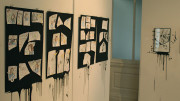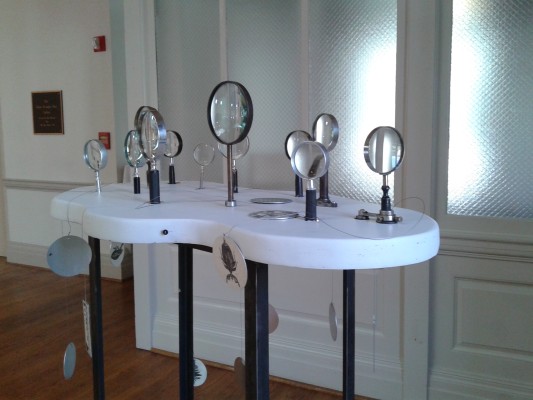I never expected to be dabbing glue onto magazine cut-outs in college, but Dr. Julia Orza was offering extra credit. Dr. Orza, through the use of arts and crafts, led us to see beyond the poster paper on the wall.
Art time in class can still send a ripple of excitement through the classroom, even at college. The goal? Create a poster that would be an advertisement for our honors class, titled Worldview and Privilege: Why Colorblind Means You Can’t See Me. Our professor, Julia Orza, split the class into three groups. Each group was set up with posters and materials. My group settled down to planning.
Our professor had given us a challenge to advertise our class, and we set forth to complete the task. It’s strange that we never stopped to wonder why. It may have something to do with Dr. Orza dangling extra credit in front of us for the best poster design.
After some debating on how to meet the challenge, my group decided to follow a suggestion made by our group member, Yichong Li. She suggested that we construct a human body using black and white photos from the magazines we were provided to represent colorblind. In class, we’ve been learning that when someone tries to be colorblind, they may unintentionally ignore another person’s background.
On our poster, outside of the figure made of black and white photos, we glued color photos showing our reality. In our world, people are different. It’s wrong to treat people with prejudice and hatred, but we can’t treat everyone exactly the same.
We can’t be colorblind. People are not the same and do not have the same experiences, and it’s ok to treat people different by being aware of their background and acknowledging their culture. If we ignore their culture and worldview, we are not giving them the respect they deserve.
As our group struggled to complete our poster by the deadline, everyone was cutting pictures frantically. Each person had a job, either finding pictures and words in the magazines, cutting them out, or gluing them to the poster. Yichong mainly directed the making of the poster and made sure our work came together. Everyone had a part and there was a sense of accomplishment when Dr. Julia Orza called “time.”
Turning from our poster, we began to observe the others and noted a severe difference among the posters. At first I wondered why the other groups had decided against using their magazines. The first group had drawn a giant eye that said “Worldview,” where the blue iris was the “o” and the pupil was an image of planet Earth. The entire poster read “Worldview and Privilege” in gray and blue. The eye represented an individual’s view of their world.
The second group had a picture of Earth, drawn in colored pencil, working on a puzzle. Below were the words, “Let’s Piece Together Your Worldview.” The puzzle pieces represented the parts of an individual’s worldview. Puzzle pieces had words representing parts of one’s worldview, such as social class, language, race, age, and sex.
It looked like the other groups hadn’t put very much effort into their posters, and I couldn’t understand why they decided against using magazines and markers. Turns out, they didn’t have magazines or markers.
My group had been presented with a bag full of scissors, glue, markers, magazines, stickers, everything but the kitchen sink. So, as we turned around, we got a bit of a shock finding one group with merely colored pencils, and the final group sporting pencils and a blue crayon. While the students from my group turned around oblivious, the other groups had a better grasp of the situation. Looking at the posters, Dr. Orza questioned whose was better. Most students spoke up saying their own was better.
Dr. Orza observed that the group with the fewest resources “were the loudest about saying how good [their poster] was.” They felt they had to “defend and speak up for their group more than the others.” Dr. Orza equated this with people of less privilege feeling the need to defend themselves. After surveying the posters, Dr. Orza chose my group, the one with the most resources, as the winner.
So what happened? Our groups had been presented with varying craft materials as a demonstration of privilege and differences in available resources. The definition of privilege is “a special right, benefit or advantage given to a person not from work, effort or merit, but by reason of membership in a majority group with the power.” The amount of privilege a person has may influence the resources available to that person.
Someone with socioeconomic privilege, who lives in an upper-class area, can print out a professional resume and has a computer to search for jobs, but a person who does not have that privilege, and who may be living on the streets, probably does not have a computer, much less a printer.
The poster project reflects the limited resources that some people have to face on a day-to-day basis, and the advantage of resources that people with the privilege and power have. Slowly, we began to dissect what had occurred.
Yichong noted, “It [seemed] like none of our group realized that others had less supplies.” I certainly didn’t notice, and I think our group received the biggest surprise to find that other people didn’t have the same resources.
Kristin Harjes, a member of the group with the colored pencils, stated, “I did not see the under-privilege of the lowest group. I only envied the privilege of the higher group. My oblivion, when it was pointed out to me, was shocking.”
There was some debate over Dr. Orza’s choosing the poster created by my group as the best one.
“I saw immediately that we were at a disadvantage,” said Jason Stein, a member of the group with the fewest resources, “but I thought she would put each of our groups into perspective when analyzing extra credit. I thought she would be judging over creativity, [using what we had], as opposed to overall appeal.”
“I was upset that she picked the [group with the most resources] to prove a point,” Kristin explained. “The materials didn’t bother me, just the final decision.”
“We had an awesome idea of designing that went into the poster,” said Yichong, “not only because we had more supplies, but also we had ideas, our artistic intuitions. Privileged people feel their ability being overlooked because of their privilege.”
When I asked Dr. Orza about choosing our group, she said, “I thought the other ones were good for what they had,” but she believed the poster that my group had created was truly the best. Normally, she wouldn’t see the creation process. If this was an actual assignment and the group with the fewest resources had turned in their poster, she says would have been like, ‘Really? You did that with just a few pencils?’”
Dr. Orza gave an example, saying that an elementary school teacher giving the assignment to a class can’t see what’s behind the scenes. One student may go home to a computer with graphic designs, or a large array of glitter glue, stickers, and colorful paper. Another student whose family is in a low socioeconomic class may have to rustle up a crinkled piece of paper and a broken crayon. The child’s parents may not be available to assist the child because of the need to work long hours. The two children return and the teacher assigns grades based upon the end results.
While observing the process, Dr. Orza noticed that the group with the least resources could only have a few people working on the poster at a time, and there were a lot of people standing around. However, the group with the most resources “never [had] a moment when people weren’t doing stuff. There was more energy.” She even caught herself becoming involved with my group, saying, “I felt I was going over to your group to make sure you used more of your stuff.” Having never tried the activity before, it came as a surprise.
Even knowing everyone’s limitations and the effort placed into the posters, Dr. Orza still expressed a preference for my group’s poster based on the end result.
Remembering the treat that was originally offered, a student asked if my group would still be getting extra credit. “Yes,” was the answer, sending a new ripple of conversation into the class.
Sarah Holbrook, member of the group with the least resources, said, “I felt really upset that they had gotten extra credit that I hadn’t gotten the opportunity to get. That made me reflect about what opportunity I [do] get that others [don’t].”
A student in my group expressed feelings of guilt for receiving extra credit because our group had an advantage in resources. On the other hand, Yichong considered, “I almost don’t feel the guilt because I felt the reason we won was because we had good ideas and it’s not just because of supplies, it’s because we had good ideas.”
From the poster activity, we brought away what?
Jason Stein, said, “I didn’t think it was the most informative project to begin with. I only realized after, when I saw the reactions of the other groups,” the affect of privilege.
Sarah Holbrook said, “It makes you more aware to the amount of difference there is in what you have available to you in resources. You grow up around people in society and don’t realize how far away others are.”
“I love that she included this in our class experience, it made me aware of privilege through real life experiences,” said Yichong Li.
Kristin Harjes said, “I think it’s fairly reflective of what we see in the real world; people see when they’re at a disadvantage, but don’t always realize when they’re the privileged ones.”





Wow! I remember you expressing this when we talked personally. I think it has been well articulated in this article. An eye-opener for everyone.